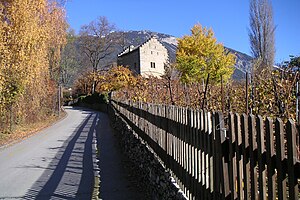Château de Muzot (also known as Maison Muzot or Muzot Castle) is a 13th-century fortified manor house located near Veyras in Switzerland's Rhone Valley.

In 1921, it was purchased by Swiss merchant and arts patron Werner Reinhart who then invited Bohemian-Austrian poet Rainer Maria Rilke (1875–1926) to live there rent-free.[1] It was at Muzot, during a few weeks in February 1922, that Rilke after a long silence caused by severe depression finally completed the Duino Elegies and wrote the entire Sonnets to Orpheus (both published in 1923).[2]
Rilke: Duino Elegies and Sonnets to Orpheus
editFrom 1921 to 1926, Muzot was the home of Bohemian-Austrian poet Rainer Maria Rilke (1875–1926). Here, after ten years of work and delays, in February 1922 Rilke finished work on the Duino Elegies, a collection of ten long poems concerning deeply mystical and philosophical themes.[3] Muzot appears in a reference within the poem cycle Sonnets from China (1936) by British poet W.H. Auden (1907–1973) who was inspired by Rilke.
Tonight in China let me think of one
Who through ten years of silence worked and waited,
Until in Muzot all his powers spoke,
And everything was given once for all.
And with the gratitude of the Completed
He went out in the winter night to stroke
That little tower like a great old animal[4]
The reference here to stroking "that little tower" is Muzot, and is derived from a series of letters written while Rilke was completing the Elegies including a letter he wrote to his current lover Baladine Klossowska,[5] and one to his former lover, Lou Andreas-Salomé. In the letter to Andreas-Salomé, he writes "I went out and stroked the little Muzot, which protected it and me and finally granted it, like a large old animal.".[6]
References
edit- ^ Freedman, Ralph. Life of a Poet: Rainer Maria Rilke. (Evanston, Illinois: Northwestern University Press, 1998),474.
- ^ Polikoff, Daniel Joseph. In the Image of Orpheus Rilke: a Soul History. (Wilmette, Illinois: Chiron Publications, 2011), 585-588.
- ^ Freedman, Ralph. Life of a Poet: Rainer Maria Rilke. (Evanston, Illinois: Northwestern University Press, 1998), passim.
- ^ Auden, W(ystan). H(ugh). "Sonnets from China", XIX, lines 8-14 (1936); first published under the title "In Time of War" in Journey to a War (1939) and later retitled "Sonnets from China."
- ^ Rilke to Baladine Klossowska (9 February 1922) in Rainer Maria Rilke, Letters to Merline 1919–1922 (St. Paul, Minnesota: Paragon House, 1989), 393.
- ^ Rilke to Lou Andreas-Salomé (11 February 1922) in Rilke, Rainer Maria and Andreas-Salomé, Lou. Briefwechsel (Insel, 1952), 464.